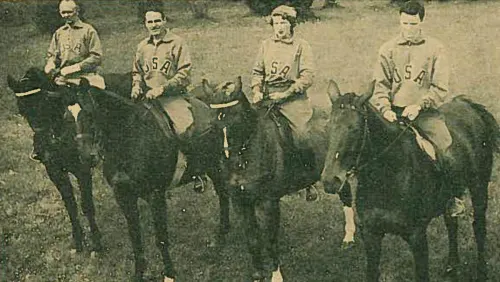This is Part 2 of an in-depth look at labor shortages and hiring challenges in the equestrian industry that first appeared in the June 12 & 19, 2023, issue of the Chronicle of the Horse. Click here to read Part 1, where we address the challenges of hiring in today’s market.
Equine business consultant Helena Harris of Stall and Stable said equine operations also need to distinguish between “finding workers and keeping them, which are two separate problems. Finding good help often depends on location, type of equine business, pay rate or other compensation opportunities. Keeping good help is more of a moving target and has a lot to do with how well one manages their business. Good communication, leadership style and fiscal responsibility all factor in when making a barn a good place to work.”
Karin Bump, a founder of the National Association of Equine Affiliated Academics and of Saddle Up NY in Madison County, New York, who has taught in equine studies at Cazenovia College (New York) and written extensively on the development of careers in the equine industry, said the days of merely trading lessons for work are over.
“The current state of our world is one with lots of jobs and fewer employees,” she says. “It’s no longer the days when people, especially young people, would work seven days a week just to be with horses.”

Free lessons and board are added benefits but no longer suffice as the sole benefits, Bump says. “Unless you are a big, fancy place that looks good on a resume, you will have to pay for interns,” she said.
Managers of horse farms need to start thinking like other businesses, and that means offering employment packages that are not just about pay and benefits but perhaps that even address retirement and quality of life issues.
“As an example, a graduate from an equine studies program moves to a new area for a job and doesn’t know anyone. That person needs a social life. So, you might need to help connect them to groups to build a social network that will help keep them there. As an employer, you need to help young people getting in the industry also have socially connected lives. The idea that people can sweep cobwebs all day won’t fly now,” Bump says.
Harris agrees that workers today are not the same as those before but says this doesn’t mean barns cannot find workers, it just means they need to rethink their approach.
“I think the labor pool has turned a corner. The perfect storm of pandemic, changing immigration policies, and a new generation of workers with different values than their predecessors means business owners have to think carefully about what inspires folks to do the hard work of barn work,” says Harris.
When consulting with businesses in the equine industry, Harris tells them to start doing more research.
ADVERTISEMENT
“Spend some time reading up on what motivates different segments of the labor market,” she says. “Many Boomers still want to work. They’re experienced, mature and reliable. Plus, retirement may mean they have more free time.
“Gen X and millennials tend to be a product of their generational environments,” she continues. “Find out what is important to these people, then think about your daily work routine. Consider which job functions would fit with their different motivations. Gen Z really wants to be fulfilled in their work, and fulfillment doesn’t necessarily mean financial. Today’s barn owner needs to find ways to help their staff feel valued as a member of the team. Generational profiling is just one way to assess the labor pool. There are other factors that shape what motivates employees. The point is to study potential job candidates the way one would study a target market: What motivates them?”
“It’s no longer the days when people, especially young people, would work seven days a week just to be with horses.”
Karin Bump
Bump admits that all of this is much harder for smaller equine operations. For them, she says, collaboration and flexibility can be key.
“You need to look at collaboration or work share programs like other small businesses do. See if other barns near you can share employees and coordinate schedules,” she says. “For part-time employees, think about how to schedule them so that they can get another job.”
And in terms of recruitment, Bump says that barns need to think outside the box. Word of mouth is good, but barn managers also need to make wide use of online job boards, reach out to colleges. “Do a broad blanket approach and look at your job listing and make sure it is appealing,” she says.
And reach out to business organizations for recruitment help.
“There are lots of organizations like small business associations that provide free business planning and mentoring, and that includes for horse farms. It can be helpful to sit with someone outside your circle and get feedback on how to recruit and market your job position,” Bump says.
Harris, as a consultant, agrees. She says that help with a financial review can make a big difference for some equine operations, such as helping them figure out how to pay the higher costs of labor.
“When a business owner uses a basic spreadsheet to compare income and expenses, cash leakages in the business become apparent,” she says. “Once those leakages are identified, finding ways to reduce or stop them becomes much easier. For example: Are your bedding costs through the roof? Try leaving the horses outside an extra hour or two. Are labor costs a challenge? Consider moving paddocks around to reduce the amount of time it takes to turn horses in and out. Anything you can do to save time will also save you money.”
ADVERTISEMENT
It’s not just about cutting costs to put money elsewhere. Harris says taking a closer look at finances helps equine operators identify missed revenue opportunities: “Are your current rates high enough? What features does your business offer that make you more valuable than the barn down the street? Can you charge more for those features? If you did charge more, how would that impact your bottom line and therefore your ability to pay competitively?”
Shrinking Immigration Force
Rethinking how to find and keep workers is likely to be critical for the equine industry going into the future—not only because the domestic pool of workers willing to do farm work is shrinking but so too is the immigrant labor force. Equine businesses, like other agriculture operations, have traditionally been reliant on immigrant labor, and U.S. immigration policy is out of the hands of the average equine business operator. According to the American Horse Council, worker caps on the H-2A and H-2B visa programs used by agriculture contributes to the tight agricultural labor pool. Thus far, immigration reform seems to be at a standstill in Congress.
Those equine business managers who do want to turn to foreign workers to meet their staffing needs can find it to be a challenging and time-consuming process, said Lauren DesRosiers, a senior staff attorney with the Immigration Law Clinic at The Justice Center at Albany Law School.
“Temporary worker visas, including H-2A and H-2B programs, allow U.S. employers to petition for temporary visas on behalf of foreign workers,” says DesRosiers. “While each situation is unique, the application process for these types of visas typically involves interfacing with and coordinating between several federal agencies. Generally, an employer must first apply for a certification from the Department of Labor before proceeding with applications with U.S. Citizenship and Immigration Services, an agency housed withing the Department of Homeland Security, and potentially interfacing with the Department of State. This can be a cumbersome and lengthy process that can present significant challenges for both the potential foreign workers as well as the U.S. employers petitioning for them.”
DesRosiers says not only is the process cumbersome, but, in many ways, U.S. immigrant worker programs are also outdated.
“These temporary worker programs originated about 80 years ago, and, although they’ve gone through several permutations since then, have retained the fundamental structure of the deeply problematic early temporary worker programs; they therefore don’t reflect the current immigration and labor realities in the United States and aren’t designed to be a solution to the overall labor shortage,” she explains.
The bottom line is that there are no quick solutions to the labor shortage in the equine industry, and horse operations will continue to face competition for workers from other businesses, both inside the horse industry and outside of it. But by asking themselves hard questions about how they operate and then doing some rethinking, businesses in the equine industry can be successful, Harris says.
“These kinds of questions don’t often come naturally to equestrians; profit margins are not their passion, horses are!” she says.
This is Part 2 of an article that appeared in the June 12 & 19, 2023, issue of The Chronicle of the Horse. You can subscribe and get online access to a digital version and then enjoy a year of The Chronicle of the Horse and our lifestyle publication, Untacked. If you’re just following COTH online, you’re missing so much great unique content. Each print issue of the Chronicle is full of in-depth competition news, fascinating features, probing looks at issues within the sports of hunter/jumper, eventing and dressage, and stunning photography.














